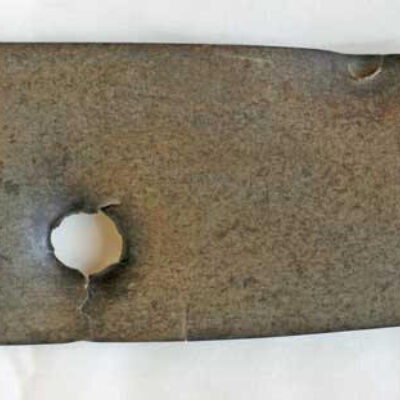
The Rosenberg Library Museum displayed a unique barong sword as the June Treasure of the Month. The artifact is part of the John C. Walker, Jr. Collection, accumulated by Lt. Walker while he was stationed in the Philippines during 1912 – 1914. The Collection was donated to the Library by Carol Walker Cameron in 1971.
The barong (also spelled “barung”) sword is an historically common weapon used in the Philippines. It is a short, wide, leaf-shaped sword with a single-edged blade. The basic components of the barong are the blade and the hilt, with the hilt composed of the grip and the pommel. The artifact featured during the month of June was pierced by a bullet during skirmishes after the Philippine-American War.
In the spring of 1911, Lt. John C. Walker, Jr. was one of four students to attend the first military school of aviation in the United States, the Glenn H. Curtiss School of Aviation at North Island, San Diego, California. He was later stationed in Parang, Philippine Islands, where skirmishes between government and armed troops still ensued after the Philippine–American War. The barong on display was collected in 1914 by Lt. Walker. The sword has one bullet hole in the center of the blade and has the indentation of another bullet closer to the edge.

The barong sword is one of several significant weapons of the Moros in the southern Philippines. The blade of the barong is very thick and heavy and generally tends to range from 18 to 24 inches in length. This combination makes the sword highly effective at slicing and chopping a variety of objects. It has become legendary for being able to cut through the barrels of muskets and rifles, including M-14 rifles, making the Moro a formidable opponent.
The handle of the sword, known as the hilt, commonly has a silver or brass sleeve which is lacquered with braided fiber rings that create an excellent grip and allow for better control over the weapon. Its classically shaped down-turned handle makes it appear similar to a machete. The hilts of barong swords used by nobles were made of ivory, water buffalo horn, or Philippine ebony. The common design of the hilt was crafted in the shape of a cockatoo, but several are known to have serpent characteristics. The counterweight of the hilt is called a pommel. Most barong pommels tend to be made from a local wood called banati (bunti) or rosewood.
The Moros, a Muslim Filipino group, live primarily in the South Philippines on the Sulu Archipelago, an island chain between the Philippines and the Island of Borneo. It is believed that their ancestors traveled to the Sulu Archipelago from the northeast as a result of the expansion of Chinese trade in the 13th and 14th centuries. The term “Moro” stems from Spanish control of the Philippine Islands and is the Spanish term for all Islamic groups. Moorish is the term applied by the Spanish to Islamic influences and decorative styles throughout Spain, Portugal, and the Philippine Islands.
The Filipino fight for independence lasted over a quarter of a century. During the 19th century, the Philippine Islands were a territory of Spain. In 1898, the First Philippine Republic officially declared independence and succeeded with the help of the United States in the Spanish-American War. The U.S., after aiding in defeat of the Spanish, tried to annex the Philippine Islands as a new American colony. The Philippine-American War arose from this struggle. The Philippine-American War was thus a continuation of the Filipino struggle for independence. Although the War only lasted from 1899 – 1902, hostilities in the region continued for several years. The Moro Rebellion, considered the second phase of the Philippine-American War, was fought between Muslim Filipino revolutionaries and the U.S. military and lasted until 1913. The Philippine Islands gained complete independence from American sovereignty in 1946.